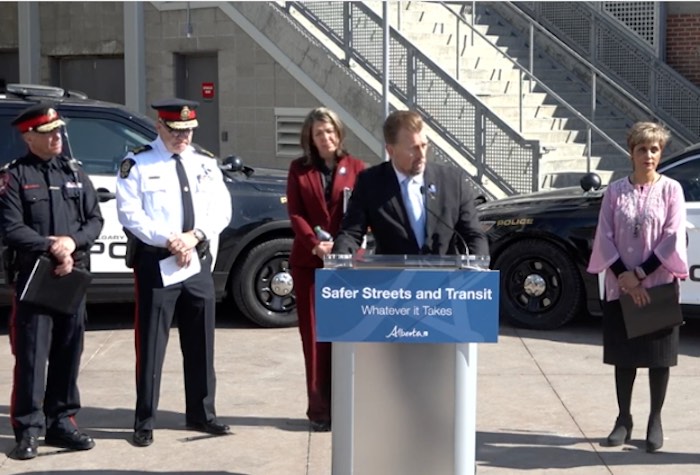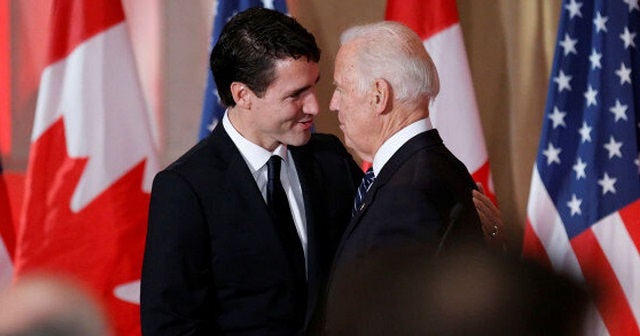Alberta
Transit safety and violent crime: Enough is enough

Alberta’s government is taking action to restore order and improve public safety in response to increasing crime and disorder in the province’s big cities.
In both Edmonton and Calgary, criminal activity is on the rise. Between July 2022 and January 2023, Edmonton’s LRT and transit centres experienced an increase in violent criminal incidents of 75 per cent. In Calgary, overall criminal occurrences at LRT stations increased 46 per cent between 2021 and 2022.
Premier Danielle Smith has directed Public Safety and Emergency Services Minister Mike Ellis to work with his cabinet colleagues to develop a plan to hire 100 more street-level police officers over the next 18 months to increase the visible law enforcement presence and tackle criminal activity in high-crime locations in Calgary and Edmonton.
“Safety on public streets is never negotiable. We can address root causes like mental health and addiction at the same time, but we will not compromise on security for all Calgarians and Edmontonians. This starts with the federal government reforming its broken catch-and-release bail system and includes us working with cities and police services to fight back against criminals.”
In addition to increasing the number of street-level police officers on city streets, Alberta’s government is encouraging the City of Calgary and the City of Edmonton to transfer command and control of transit peace officers to the Calgary and Edmonton police services. This transfer would enable the police to better lead a coordinated and strategic response to the increase in violent crime on public transit.
“Enough is enough – the rising crime levels in Edmonton and Calgary are unacceptable. Albertans have a right to use public transit and walk the streets without fear. We are working with our partners to develop a clear plan to take our cities back from those who seek to cause harm.”
Improving public safety on the cities’ transit networks also involves stations and vehicles that are clean of drug paraphernalia and debris. Through a new $5-million grant to each city, municipal governments will be able to provide the services needed to keep station platforms and vehicles clean, safe and welcoming for law-abiding Calgarians and Edmontonians.
“The safety and security of our transit systems and downtowns will remain a top priority. No single order of government can solve this issue alone. We will continue to work together by deploying our safety resources in an integrated and collaborative way.”
“We are seeing a significant portion of those who are improperly using transit and other public spaces becoming entrenched, with many displaying resistance to offers for services, as well as reduced cooperation and compliance with authority figures. For those people, consequences will follow.”
Police and crisis teams
As part of building strong recovery-oriented systems of mental health and addiction care, Alberta’s government is investing almost $8 million over three years to increase the number of police and crisis teams (PACT) in Calgary and Edmonton. PACT pairs police constables with mental health therapists from Alberta Health Services to respond to 911 calls where there is a mental health concern. Police and mental health therapists work together to assess a client’s mental health challenge and determine what support is required to keep the individual and the community safe.
“We are taking a fair, firm and compassionate approach to keeping our communities safe while treating mental health and addiction as health-care issues. By working with our partners in the Calgary and Edmonton police services, we can connect people in need with critical mental health services and better address the social issues affecting our two largest cities.”
With this funding, Alberta’s government is adding 12 new PACT partnerships in each city. This will double the number of PACT teams in Calgary, increasing from 12 to 24, and triple them in Edmonton, increasing from six to 18. These partnerships will better support Albertans struggling with mental health challenges while improving public safety for everyone.
“These additional resources will help us to gather what we need to get ahead of the concerning spike in crime and particularly violent crime that we are witnessing in areas like our downtown core and transit stations across Edmonton. The support, not just for police but for PACT, means prioritizing those who need support while ensuring appropriate focus on safety. Centring police as leaders within this work shows a key understanding that we cannot have well-being if we don’t have safety.”
Quick facts
Edmonton crime:
- The average crime severity index in downtown Edmonton has increased 29 per cent, to 116 in December 2022 from 90 in July 2022, driven primary by an increase in serious criminal offences, in particular second-degree murder, assault causing bodily harm with a weapon, robbery and aggravated assault.
- In Edmonton, a person is about twice as likely to be victimized by a stranger at a transit centre than for the city as a whole (70 per cent at LRT transit versus 36 per cent citywide).
Calgary crime:
- Property crime occurrences in Calgary nearly doubled – increasing 95 per cent to 463 in 2022, up from 238 in 2021.
- Total calls for service to Calgary LRT stations increased to 9,317 in 2022, up 39 per cent from 6,706 in 2021.
- Public-generated calls for service to LRT stations increased to 5,012 in 2022, up 20 per cent from 4,160 in 2021.
- Officer-generated calls for service to LRT stations increased to 4,305, up 69 per cent from 2,546 in 2021.
PACT facts:
- Police and crisis teams (PACT) offer mental health assessment, support and/or consultation in crisis situations. Mental health therapists work with police constables to assess mental health needs and determine appropriate action in accordance with the Mental Health Act and the criminal justice system.
Alberta
Alberta government should eliminate corporate welfare to generate benefits for Albertans

From the Fraser Institute
By Spencer Gudewill and Tegan Hill
Last November, Premier Danielle Smith announced that her government will give up to $1.8 billion in subsidies to Dow Chemicals, which plans to expand a petrochemical project northeast of Edmonton. In other words, $1.8 billion in corporate welfare.
And this is just one example of corporate welfare paid for by Albertans.
According to a recent study published by the Fraser Institute, from 2007 to 2021, the latest year of available data, the Alberta government spent $31.0 billion (inflation-adjusted) on subsidies (a.k.a. corporate welfare) to select firms and businesses, purportedly to help Albertans. And this number excludes other forms of government handouts such as loan guarantees, direct investment and regulatory or tax privileges for particular firms and industries. So the total cost of corporate welfare in Alberta is likely much higher.
Why should Albertans care?
First off, there’s little evidence that corporate welfare generates widespread economic growth or jobs. In fact, evidence suggests the contrary—that subsidies result in a net loss to the economy by shifting resources to less productive sectors or locations (what economists call the “substitution effect”) and/or by keeping businesses alive that are otherwise economically unviable (i.e. “zombie companies”). This misallocation of resources leads to a less efficient, less productive and less prosperous Alberta.
And there are other costs to corporate welfare.
For example, between 2007 and 2019 (the latest year of pre-COVID data), every year on average the Alberta government spent 35 cents (out of every dollar of business income tax revenue it collected) on corporate welfare. Given that workers bear the burden of more than half of any business income tax indirectly through lower wages, if the government reduced business income taxes rather than spend money on corporate welfare, workers could benefit.
Moreover, Premier Smith failed in last month’s provincial budget to provide promised personal income tax relief and create a lower tax bracket for incomes below $60,000 to provide $760 in annual savings for Albertans (on average). But in 2019, after adjusting for inflation, the Alberta government spent $2.4 billion on corporate welfare—equivalent to $1,034 per tax filer. Clearly, instead of subsidizing select businesses, the Smith government could have kept its promise to lower personal income taxes.
Finally, there’s the Heritage Fund, which the Alberta government created almost 50 years ago to save a share of the province’s resource wealth for the future.
In her 2024 budget, Premier Smith earmarked $2.0 billion for the Heritage Fund this fiscal year—almost the exact amount spent on corporate welfare each year (on average) between 2007 and 2019. Put another way, the Alberta government could save twice as much in the Heritage Fund in 2024/25 if it ended corporate welfare, which would help Premier Smith keep her promise to build up the Heritage Fund to between $250 billion and $400 billion by 2050.
By eliminating corporate welfare, the Smith government can create fiscal room to reduce personal and business income taxes, or save more in the Heritage Fund. Any of these options will benefit Albertans far more than wasteful billion-dollar subsidies to favoured firms.
Authors:
Alberta
Official statement from Premier Danielle Smith and Energy Minister Brian Jean on the start-up of the Trans Mountain Pipeline

-

 Addictions1 day ago
Addictions1 day agoCity of Toronto asks Trudeau gov’t to decriminalize hard drugs despite policy’s failure in BC
-

 Business1 day ago
Business1 day agoWhen politicians gamble, taxpayers lose
-

 Automotive1 day ago
Automotive1 day agoVehicle monitoring software could soon use ‘kill switch’ under the guise of ‘safety’
-

 International2 days ago
International2 days agoU.S. birth rate hit record low last year, signaling surge in childlessness
-

 Environment2 days ago
Environment2 days agoClimate Alarmists Want To Fight The Sun. What Could Possibly Go Wrong?
-

 Bruce Dowbiggin1 day ago
Bruce Dowbiggin1 day agoIt Gets Late Early These Days: Time To Bounce Biden & Trudeau?
-

 National1 day ago
National1 day agoBritish Columbia quickly shoots down bill to ban men from competing in women’s sports
-

 Economy22 hours ago
Economy22 hours agoOttawa’s homebuilding plans might discourage much-needed business investment









